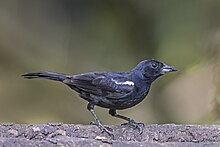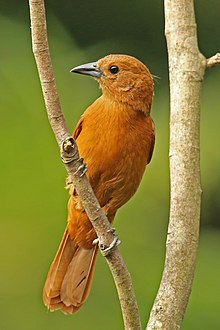White-lined tanager
| White-lined tanager | |
|---|---|

| |
| male, Colombia | |

| |
| female, Trinidad | |
| Scientific classification | |
| Domain: | Eukaryota |
| Kingdom: | Animalia |
| Phylum: | Chordata |
| Class: | Aves |
| Order: | Passeriformes |
| Family: | Thraupidae |
| Genus: | Tachyphonus |
| Species: | T. rufus |
| Binomial name | |
| Tachyphonus rufus (Boddaert, 1783) | |

| |
| Synonyms | |
|
Tangara rufa (protonym) | |
The white-lined tanager (Tachyphonus rufus) is a medium-sized passerine bird in the tanager family Thraupidae. It is a resident breeder from Costa Rica south to northern Argentina and on the islands of Trinidad and Tobago.
Taxonomy
The white-lined tanager was described by the French polymath Georges-Louis Leclerc, Comte de Buffon in 1779 in his Histoire Naturelle des Oiseaux from specimens collected in Cayenne, French Guiana.[2] The female bird was also illustrated in a hand-coloured plate engraved by François-Nicolas Martinet in the Planches Enluminées D'Histoire Naturelle which was produced under the supervision of Edme-Louis Daubenton to accompany Buffon's text.[3] Neither the plate caption nor Buffon's description included a scientific name but in 1783 the Dutch naturalist Pieter Boddaert coined the binomial name Tangara rufa in his catalogue of the Planches Enluminées.[4] The white-lined tanager is now placed in the genus Tachyphonus and was introduced by the French ornithologist Louis Pierre Vieillot in 1816 with the white-lined tanager as the type species.[5][6][7] The name combines the Ancient Greek words takhus "fast" and phōneō "to speak".[8] The specific rufus is Latin for "red", "ruddy" or "rufous".[9] The species is monotypic: no subspecies are recognised.[7]
Description
The adult white-lined tanager is 18.5 cm (7.3 in) long and weighs 33 g (1.2 oz). It has a long tail and a mostly black stout pointed bill. The adult male is glossy black, apart from white underwing coverts and a small white patch on the upperwing. These white areas are conspicuous in flight but otherwise rarely visible. Females and immatures are entirely rufous in plumage, somewhat paler below.
Distribution and habitat
It occurs in semi-open areas including gardens.
Behaviour and ecology
Breeding
In the breeding season, the male displays the white spots which he has under his wings, opening them and closing them before in front of the female.[10] The bulky cup nest is built in a tree or shrub, and the female incubates three, sometimes two, brown-blotched cream eggs for 14–15 days. This species has, on average, two broods per season.[10] They appear to be territorial, as only one nesting pair is usually seen in an area. They rarely join mixed feeding flocks.[10] The white-lined tanager's song is a fast repetitive cheeru.
Food and feeding
These are restless but unwary birds which eat a wide variety of fruit, especially epiphytes. They also take some nectar and insects, including beetles, ants, and grasshoppers.
Local names in Trinidad and Tobago include 'Parson' (for the male), and 'Singing Angel'; on these islands, the species is highly valued for its whistling ability.
Gallery
- Female
- Male
- pair feeding at Asa Wright Nature Centre
References
- ^ BirdLife International (2018). "Tachyphonus rufus". IUCN Red List of Threatened Species. 2018: e.T22722400A132152966. doi:10.2305/IUCN.UK.2018-2.RLTS.T22722400A132152966.en. Retrieved 12 November 2021.
- ^ Buffon, Georges-Louis Leclerc de (1779). "Le tangara noire et le tangara roux". Histoire Naturelle des Oiseaux (in French). Vol. 7. Paris: De L'Imprimerie Royale. pp. 361–362.
- ^ Buffon, Georges-Louis Leclerc de; Martinet, François-Nicolas; Daubenton, Edme-Louis; Daubenton, Louis-Jean-Marie (1765–1783). "Le tangaroux, de Cayenne". Planches Enluminées D'Histoire Naturelle. Vol. 8. Paris: De L'Imprimerie Royale. Plate 711.
- ^ Boddaert, Pieter (1783). Table des planches enluminéez d'histoire naturelle de M. D'Aubenton : avec les denominations de M.M. de Buffon, Brisson, Edwards, Linnaeus et Latham, precedé d'une notice des principaux ouvrages zoologiques enluminés (in French). Utrecht. p. 44, Number 711.
- ^ Vieillot, Louis Pierre (1816). Analyse d'une Nouvelle Ornithologie Élémentaire (in French). Paris: Deterville/self. p. 33.
- ^ Paynter, Raymond A. Jr, ed. (1970). Check-list of Birds of the World. Vol. 13. Cambridge, Massachusetts: Museum of Comparative Zoology. p. 288.
- ^ a b Gill, Frank; Donsker, David, eds. (2019). "New World warblers, mitrospingid tanagers". IOC World Bird List Version 9.2. International Ornithologists' Union. Retrieved 4 October 2019.
- ^ Jobling, J.A. (2018). del Hoyo, J.; Elliott, A.; Sargatal, J.; Christie, D.A.; de Juana, E. (eds.). "Key to Scientific Names in Ornithology". Handbook of the Birds of the World Alive. Lynx Edicions. Retrieved 2 April 2018.
- ^ Jobling, James A. (2010). The Helm Dictionary of Scientific Bird Names. London: Christopher Helm. p. 341. ISBN 978-1-4081-2501-4.
- ^ a b c "Pipira-preta". Wikiaves (in Portuguese). Retrieved 18 September 2014.
- ffrench, Richard (1991). A Guide to the Birds of Trinidad and Tobago (2nd ed.). Comstock Publishing. ISBN 0-8014-9792-2.
- Hilty, Steven L (2003). Birds of Venezuela. London: Christopher Helm. ISBN 0-7136-6418-5.
External links
- "White-lined Tanager media". Internet Bird Collection.
- White-lined tanager photo gallery at VIREO (Drexel University)
- White-lined Tanager Tachyphonus rufus at Arthur Grosset's South American Birds Website
- White-lined Tanager photos in "Trinidad and Tobago Birds" album by "terrythormin" at pbase.com
- White-lined tanager species account at Neotropical Birds (Cornell Lab of Ornithology)
- Interactive range map of Tachyphonus rufus at IUCN Red List maps
- Audio recordings of White-lined tanager on Xeno-canto.




